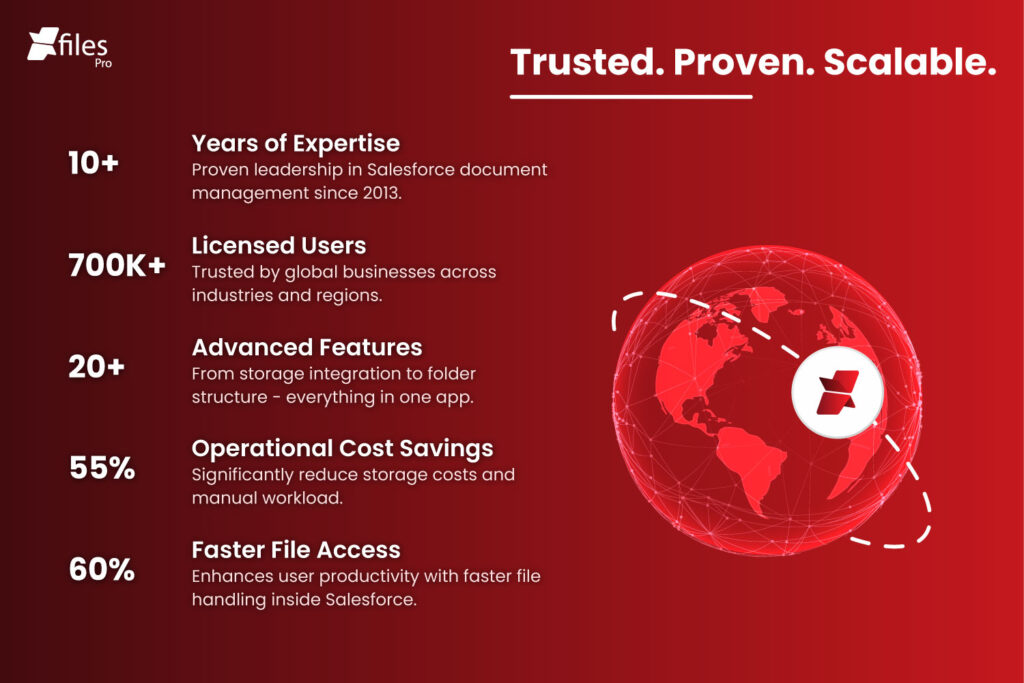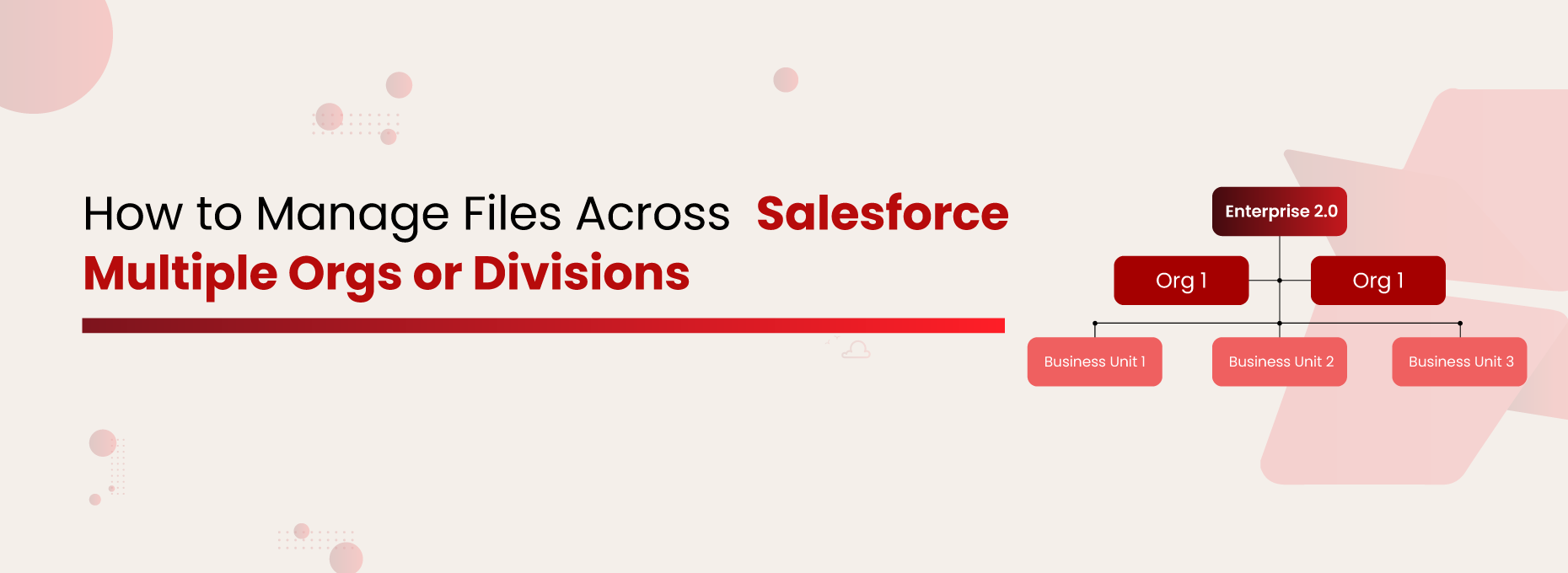Poornima G
Most multinational companies (MNCs) use multiple Salesforce orgs across different regions, and for good reasons. Multi-org setups allow companies to manage operations independently across geographies, subsidiaries, or business units, each with its own processes, data models, and compliance needs. This approach helps maintain flexibility while adhering to regional regulations and business goals.
While this approach solves many operational challenges, it also creates new ones. Files get scattered, data becomes disconnected, and teams struggle to access the documents they need quickly. This slows down collaboration, leads to duplication of work, and causes storage costs to climb higher than expected.
Whether it’s sales teams, support teams, or partner networks, everyone ends up wasting time switching between orgs or resorting to emails and external drives just to find basic information.
That’s why global businesses using the Salesforce multi-organization strategy must rethink their approach. By centralizing file management across Salesforce orgs, they’re making life easier for their teams, providing quick access to the right files, less duplication, better storage use, and peace of mind with legal compliance. Everything teams need, all in one place.
Why Companies Use Salesforce Multiple Orgs
Companies don’t choose multiple orgs just for their own sake. Often, it’s driven by practical needs. Sometimes it’s due to simple issues like file size limits or storage capacity. Other times, it’s more complex factors like data residency rules, legal compliance, or operational independence across countries or business units.
Salesforce has multiple orgs that exist to help businesses remain flexible and compliant across various markets. However, without an effective file management strategy, these multiple orgs can lead to operational difficulties.
The Hidden Problems of Managing Salesforce Multiple Orgs
When organizations run multiple divisions under different Salesforce orgs, managing documents often turns into a frustrating task. Instead of being valuable assets, files become a problem.
Here are some questions you might have
Why Can’t I Just Find That File?!
When using Salesforce multi-org, every org becomes its own data island. Imagine trying to renew a global customer contract. Your US team needs to see a signed agreement uploaded in the UK org. Without a simple, centralized way to access files, teams often get stuck. They either need admin approvals, log into multiple orgs, or manually export and share files, just to complete basic tasks. That’s hours wasted.
Wait…Is This The Final Document?
Without proper syncing, you end up with multiple versions of the same file in different orgs. Sales accidentally shares an outdated pricing sheet because the latest version was in a different org. And your business risks losing the deal or delivering the wrong information to the customer.
Why Does My Storage Bill Look Like a Phone Number?
Salesforce storage is expensive, and when multiple orgs store files separately, you pay for the same storage problem multiple times.
Let’s break it down step by step:
- You have 5 orgs.
- Each org costs $5/month/GB for file storage.
- Total cost per GB across 5 orgs = 5 × $5 = $25/GB/month.
- If you store 50GB total (across all orgs), it would be: 50GB × $25/GB = $1,250/month just for storing 50GB of files.
Audit Time? Brace for the Panic.
Managing sensitive data across multiple Salesforce orgs gets risky. You can’t easily track who accessed what file or where confidential documents are stored. This creates gaps during GDPR, HIPAA, or financial audits.
During an audit, the legal team asks for a report on customer document access. You need to pull file activity from five different orgs, wasting days while auditors wait, turning what should be a routine process into a last-minute scramble.
Why Am I Always Asking for Files?
When files are stuck in their respective orgs, cross-divisional collaboration breaks down. Teams waste time on back-and-forth emails asking for files instead of focusing on actual work.
For example, your customer support team needs an onboarding document uploaded by sales. Still, because it’s stuck in a different org, support teams are left chasing people for files, delaying responses, and frustrating customers.
Customers Notice When You Don’t Have It Together
When customer documents are split across orgs, there’s no single source of truth. Customers receive inconsistent information, or worse, you delay responses because internal teams can’t find what they need.
This leads to missed opportunities, slower customer service, and damages your brand reputation.
So, how do leading companies overcome these challenges? Let’s explore the best ways to simplify and centralize Salesforce file management
Top Ways to Manage Salesforce Files Across Multiple Orgs or Divisions
Working with multiple Salesforce orgs is a task in itself, and as your business scales, it’s crucial to have strategies that scale with you. Documents are at the heart of every business process, and without a proper system in place, things can quickly get disorganized, messy, and non-compliant. That’s exactly why major enterprises and MNCs are moving towards centralized file management.
Here are proven, actionable strategies to help you manage Salesforce files the right way:
Use a Centralized External Storage Solution
Instead of endlessly buying more Salesforce storage, where your bill starts to look like a phone number, smart businesses are opting for external storage solutions. Platforms like SharePoint, AWS S3, Google Drive, and OneDrive offer robust document management capabilities with more flexibility and lower costs.
Automate File Offloading
Manually moving files out of Salesforce is tedious and error-prone. Automating file offloading seamlessly shifts inactive or large files to external storage based on custom rules to save storage space, reduce clutter, and keep your Salesforce orgs running smoothly.
Create a Consistent, Structured Folder System
A scattered file system slows everyone down. That’s why having a well-structured folder hierarchy is key, especially when managing multiple Salesforce orgs or divisions. By implementing a standardized folder structure (based on accounts, opportunities, case types, or departments or org), you make it easier for teams to locate, upload, and manage documents without confusion.
Upgrade to Organized File Management with Structured Folders
Sync Files Effortlessly Across Orgs
One of the biggest struggles with Salesforce multiple orgs is keeping files in sync. Enabling real-time file syncing between Salesforce orgs and your centralized storage ensures updates happen automatically, and every team always sees the latest version. This keeps your teams aligned with accurate, up-to-date documents regardless of the org they use. It eliminates miscommunication and ensures consistent information across all regions.
Simplify Internal and External File Sharing
Apply Role-Based Access Control
Role-based access ensures only authorized personnel can view, edit, or share files, reducing data leaks. Manage access centrally across orgs, avoiding inconsistent sharing rules and manual permission errors. This approach enhances document security while making access management more streamlined and less prone to human error.
By now, it’s clear that decentralizing file management across multiple Salesforce orgs can slow down operations, increase costs, and hurt the customer experience. The right tool can simplify these processes and set your teams up for success.
And that tool is XfilesPro, trusted by 700k+ licensed users worldwide. XfilesPro helps you effortlessly offload, sync, share, and secure files across multiple Salesforce orgs, eliminating manual work, reducing storage costs, and keeping your teams efficient, aligned, and always up-to-date.
The Go-To Guide for Better Document Management
How XfilesPro Simplifies Salesforce Multi-Org File Management
Purpose-built for Salesforce users, XfilesPro eliminates the hassle of fragmented file storage by centralizing file management under one secure, streamlined system.

Here’s how XfilesPro simplifies file management across multiple Salesforce orgs or divisions:
- External Storage Integration: You can connect all your Salesforce orgs, whether it's two or ten, to a centralized external storage platform (SharePoint, Google Drive, AWS S3, or OneDrive).
- Automated Cross-Org File Sync: Any file associated with a case creation or update in one Salesforce org is automatically reflected in the connected orgs. XfilesPro ensures real-time file synchronization across multiple Salesforce orgs and external storage without any manual effort.
- Unified Document Access: No matter which Salesforce org your teams belong to, XfilesPro provides consistent access to files stored externally for authorized users.
- Reduced Storage Costs: By offloading files from multiple Salesforce orgs to external storage, you drastically cut down on expensive Salesforce storage usage, saving thousands of dollars annually.
- Easier Compliance & Security: XfilesPro simplifies file governance across multiple orgs. With robust access controls, audit trails, and encryption options, you maintain compliance and data security without complicated setups.
- Scalable as You Grow: Whether you're a growing enterprise or a global organization with multiple Salesforce orgs, XfilesPro scales with you, ensuring file management remains efficient as your operations expand.
Use Case
One of our customers faced the challenge of syncing cases, contacts, accounts, and attachments across two different Salesforce orgs—one on Classic, one on Lightning. With cases coming in from multiple sources, including email-to-case, they needed a way to automatically reflect all case updates and attachments in both orgs without manual work.
Conclusion
While Salesforce’s multiple orgs serve critical business needs, like regulatory compliance, operational independence, and regional autonomy, they often create unnecessary hurdles when it comes to file storage, access, and sharing. Without a streamlined system, businesses risk operational inefficiencies, ballooning storage costs, and poor customer experiences.
That’s why modern enterprises are shifting towards centralized file management with tools like XfilesPro. With external storage integration, real-time file sync, unified access, and automated offloading, XfilesPro transforms how businesses handle documents across multiple Salesforce orgs. It eliminates manual work, cuts costs, boosts productivity, and keeps your teams aligned with up-to-date, easily accessible files, no matter the org or division.





